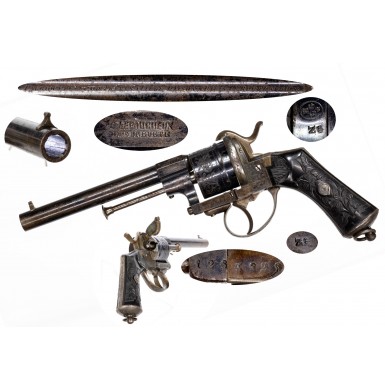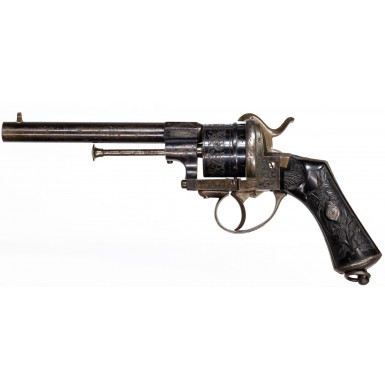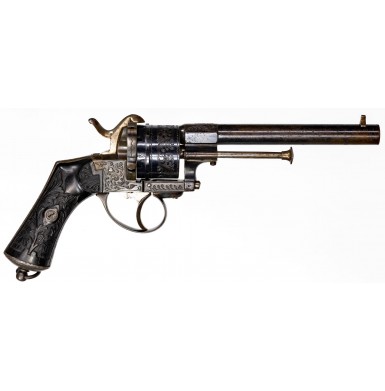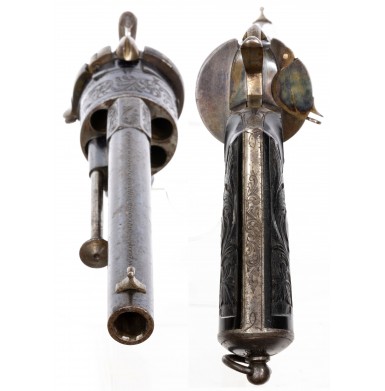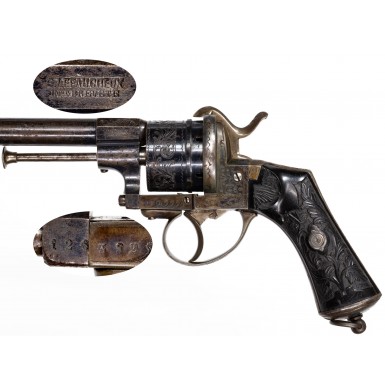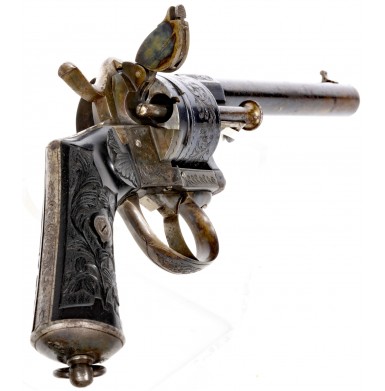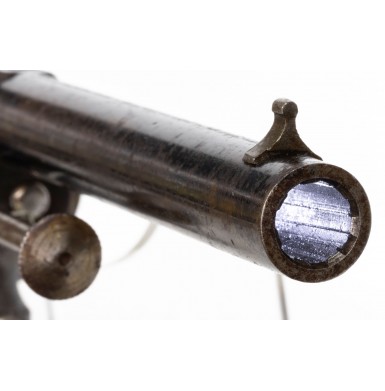Fine Double Action Lefaucheux Patent 12mm Revolver by LePage Frères of Liège
- Product Code: FHG-3451-SOLD
- Availability: Out Of Stock
-
$1,695.00
In 1835, Casimir Lefaucheux developed what would become the first truly successful self-contained cartridge system, which would become known world-wide by its method of ignition; the “Pin Fire”. Lefaucheux was a French gunsmith and inventor who had been born in 1802, only a year before the Napoleonic Wars would plunge Europe into a dozen years of nearly constant conflict. Lefaucheux was not the first to experiment with combining the powder, projectile and ignition source into a single, easy to handle cartridge. In fact, Swiss-born French gunmaker Samuel Joannes Pauly probably created the first workable system about a decade after Lefaucheux’s birth. It was to Pauly that young Casimir was apprenticed to at the age of 12, and where he learned the gun-building trade. In fact, by 1827 Lefaucheux was the manager of Pauly’s Paris establishment and very soon thereafter, Casimir became the owner of the company. What Lefaucheux can be credited with was that he was the first to come up with a broadly successful and reliable self-contained cartridge system. Although the pin fire cartridges that we think of today are metallic, Lefaucheux’s new cartridge used a cardboard tube to contain the black powder, lead bullet and pin fire primer. It would not be until more than a decade later that improvements in Lefaucheux’s revolutionary design by Benjamin Houllier would result in the metallic cartridge that we think of today as a “pin fire”. Due to a French government that felt military arms production was strictly for their national armories and not for private contractors, Casimir concentrated on the manufacture of sporting arms. He applied his cartridge design to arms for that market, including breechloading shotguns and single shot pistols. It was Casimir’s son Eugene who would put the Lefaucheux name indelibly on the map with his revolutionary revolver design.
Eugene had an interest in applying the pin fire concept to a revolving pistol, and in 1851 he exhibited such a handgun at the London Exhibition. The revolver was revolutionary in that the cartridges loaded from the rear of the cylinder, which had bored through chambers. Any student of firearms history will immediately note that in America, the concept of the “bored through” cylinder is attributed Rollin White. White’s US patents #12,648 and #12649, granted on April 3, 1855, granted him sole control of this essential design element for any metallic cartridge revolver until the patent expired in 1869. White subsequently entered into an agreement with Smith & Wesson, granting them the right to produce revolvers that incorporated his patent in exchange for a .25 cent per gun royalty payment. By so doing, White essentially granted Smith & Wesson a monopoly on the most efficient cartridge revolver design and kept major manufacturers like Colt and Remington from being able to compete in the cartridge revolver market while the patent restrictions were in effect. However, Lefaucheux’s design pre-dated White’s patent by at least four years, and Lefaucheux received a French patent for the concept (#19,380) on April 15, 1854, almost exactly a year prior to White receiving his American patent for the same principle. Had Lefaucheux the younger been forward thinking enough to register his patent in America, the history of American cartridge handgun design would have been very different, and it is arguable that Smith & Wesson might not have become the industry leader that they remain today. In fact, Smith & Wesson might even have failed financially during their first decade in business.
Eugene Lefaucheux’s design, that would become known as the Model 1854 Pin Fire Revolver, was based upon his original 15 April 1854 patent, but also on additional modifications to the original patent, which he registered on June 10 and November 9 of the same year. The revolver depicted in Lefaucheux’s patent application bore a strong resemblance to the Colt Model 1851 Navy revolver, including the open-top frame, octagonal barrel and single action lock work. His patent drawing even included the square-backed triggerguard of the earliest production Colt M1851. The primary differences between the Colt and Lefaucheux’s design were the inclusion of a hinged loading gate where the Colt had the frame cut out for capping, the inclusion of an ejector rod along the lower right hand side of the barrel to push the spent cases out of the cylinder and of course the inclusion of the six bored-through chambers in the cylinder for metallic cartridges. Interestingly, the patent drawing looks very much like a Richards-Mason cartridge alteration of a square-backed Colt Navy revolver, almost two decades before Colt produced these conversions!
The following year, Lefaucheux submitted his new revolver design to the French military for testing. The French Navy wanted to replace the single-shot percussion muzzleloading pistols then in service, and the pistols selected for evaluation were the Colt M1851 Navy, the M1854 Beaumont-Adams and the Lefaucheux design. Whether it was nationalism or simple practicality is hard to know, but from the outset the French Navy had determined that the only acceptable pistol would be one that used self-contained metallic cartridge ammunition, so by default the percussion ignition designs from Colt and Adams never had a chance of acceptance. The Lefaucheux design was officially chosen as the winner in 1857 and entered service with the French Navy the following year as the Model 1858. It is interesting to note that the one area of testing where the Colt revolver was clearly superior to the Lefaucheux was in the actual power of the cartridge. The cap and ball Colt fired a round lead ball of .36 caliber at about 750 feet per second, generating a muzzle energy of about 152 ft/lbs. In terms of modern ammunition, this amount of muzzle energy is about the same as the .32 ACP, not exactly known as a “man stopping” round. However, the 12mm cartridge fired by the Lefaucheux had a woefully slow muzzle velocity of about 330 ft/s, and a muzzle energy of about 52 ft/lbs; about one third the power of the Colt Navy’s projectile and slightly less muzzle energy than the modern .25 ACP, a cartridge that is certainly ridiculed in terms of stopping power. This lack of power was likely a combination of many factors, including the limited amount of space in the cartridge case for the black powder propellant and the inherent weakness in metallurgy of the copper cases of the time, which would severely limit the pressures the cartridge cases could be exposed to without rupturing.
Despite the woefully underpowered cartridge, Lefaucheux’s design would be the most widely issued martial cartridge revolver of the American Civil War. Thousands of these pinfire revolvers were imported for use by US troops, and at least a few hundred saw service with Confederate troops as well. The typical “Civil War” used pin fire revolver was the military pattern M1854 in 12mm. Most these guns had octagon to round barrels that measured between about 5.75” and 6.25”, although some wider variation has been noted. Most had a spurred triggerguard and a lanyard ring in the butt. Lefaucheux revolvers were produced with both blued and bright finishes, and it appears that the guns that were imported were a mixture of both finishes. Some 12,333 M1854 Lefaucheux patent pin fire revolvers are recorded as having been officially purchased by the US government during the America Civil War, with 11,833 being delivered. Additionally, more than 2.2 million pin fire cartridges were acquired by the Federal Ordnance Department, primarily from domestic sources. However, surviving examples and regimental records indicate that more than the “official” number were probably imported, especially when southern use is considered.
With Eugene’s military pattern revolver accepted by the French Navy and in use in a conflict on the other side of the Atlantic Ocean, he had proved that design was a successful military one. With that market firmly in his grasp for the time being, Eugene started to explore the civilian arms market more adequately. This meant introducing pin fire revolvers for the general public in a variety of sizes and calibers for different purposes. Most of these guns were produced in 7mm, 9mm and the earlier 12mm caliber and in sizes ranging from palm-sized, folding trigger 7mm pocket guns through mid-sized (sometimes referred to as belt sized) 7mm and 9mm revolvers and larger 12mm holster sized revolvers. Many of the guns utilized a double action lock work, with the guns designed for pocket carry often employing a folding trigger and no triggerguard; for ease of concealment and drawing from a coat pocket. Lefaucheux found strong success in the sale of these civilian handguns and the pin fire became wildly popular in Europe and Great Britain with many more of the guns being produced by the Liège gun trade in Belgium, as well as the Birmingham trade in England.
Offered here is a FINE condition example of one of those Liège produced double action revolvers that dates to the 3rdquarter of the 19th century. The gun was produced by the famous Belgian gunmaking firm of LePage Frères and is clearly engraved on the top of the 6.25” octagon to round barrel:
FABRIQUE DE LEPAGE FRERES A LIEGE MAISON A PARIS 12 RUE D’ENGHEIN
The firm was a partnership between the brothers Charles and Alphonse LePage and was in business from 1857-1868. In 1868 the firm became LePage & Chauvot. The brothers manufactured their guns in Liege but offered them for sale in both Liège and Paris. This gun has the Paris retail address on the barrel. The LePage family was a multi-generational family of gunsmiths that had begun with Francois LePage who worked in Liege circa 1770-1813. The Belgian family was not related to the LePage gunmaking dynasty of Paris.
The 12mm Fgun is a double-action only design, indicated by the fact that the cylinder can be rotated with the hammer in the “down” or “fired” position. Firing is only accomplished by pulling the trigger and operating the gun in double action mode, as there is no cocking notch. Like most Lefaucheux designs, a hinged loading gate is present in the rear of the right side of the recoil shield and an ejector rod is present along the right side of the barrel. The grip has the saw handle profile, common on many English and Continental double action revolvers of the period. The gun has relief carved ebony grips with a foliate theme and a lanyard ring in the butt. A typical triangular-shaped front sight base supports a barely corn style front sight bead. The left side of the frame is marked with the serial number 126392 below the cylinder. The left side of the octagonal portion of the barrel is stamped in two lines:
E LEFAUCHEUX
INVR BREVETE
The cylinder is marked with a typical E/LG/* Liege proof mark in an oval with a {CROWN}/N controller mark, and the same controller mark is found on the lower right side of the barrel web. The gun is engraved with flowing foliate themes on the frame and cylinder with simple engraved intertwined line decorations on the backstrap, and more foliate themes on the triggerguard and butt cap.
As noted, the gun remains in about FINE condition. The gun retains much of its original blued finish on the barrel and cylinder and a significant amount of original color casehardening on the frame. The barrel retains about 30% of the blue with moderate flaking, thinning and loss. The exposed areas of metal have a muted bluish-gray patina. The cylinder retains about 85%+ of its original blue with some thinning and wear. The frame retains about 75% of its original case hardening with the grip frame retaining only some traces with scattered surface oxidation and muted and mottled brownish gray patina. There is some scattered surface oxidation and surface roughness on the backstrap and gripstrap and scattered here and there on the gun.
The revolver remains mechanically functional and as noted the cylinder rotates for loading and unloading while the hammer is in the down position. The double action trigger mechanism operates correctly as well. As noted above, the design was not intended for single action use. Pulling the trigger correctly indexes the cylinder, raises the hammer, and releases it. The only mechanical issue noted is that the trigger return spring is either weak or broken and the trigger must be reset manually after firing. The original ejector rod is also present and remains functional as well and the loading gate remains fully functional and locks into place as it should. The frame to barrel fit is very tight and secure. The bore of the revolver is in about FINE condition. The bore is mostly bright with scattered light pitting along its length but with strong rifling that is cut with a very slow rate of twist. The original front sight is in place at the end of the barrel and the original lanyard ring is in place in the butt. The grips are in about FINE condition as well. They fit the revolver perfectly and the relief carving remains crisp and well defined. The grips do show some scattered minor bumps and dings from handling and use, but no abuse.
Overall, this is a lovely example of a double action Lefaucheux Patent Pin Fire Revolver by the LePage Brothers of Liege. The gun shows some light wear and use but a very attractive and pleasing appearance. This would be a fine addition to any collection of mdi-19th century European handguns, of pinfires or to any general collection of high-grade antique handguns.
SOLD
Tags: Fine, Double, Action, Lefaucheux, Patent, 12mm, Revolver, by, LePage, Frères, of, Liège

